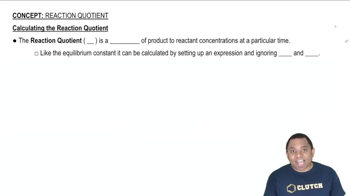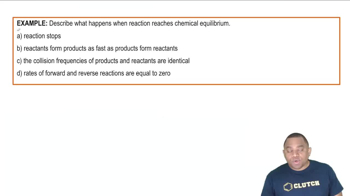(a) If Qc < Kc, in which direction will a reaction proceed in order to reach equilibrium?
Ch.15 - Chemical Equilibrium

Brown14th EditionChemistry: The Central ScienceISBN: 9780134414232Not the one you use?Change textbook
Chapter 15, Problem 41b
(b) What condition must be satisfied so that Qc = Kc?
 Verified step by step guidance
Verified step by step guidance1
The reaction quotient, , is calculated using the concentrations of the reactants and products at any point in time, not necessarily at equilibrium.
The equilibrium constant, , is calculated using the concentrations of the reactants and products at equilibrium.
For to equal , the system must be at equilibrium, meaning the concentrations of reactants and products have reached a state where they no longer change with time.
Therefore, the condition that must be satisfied for = is that the reaction mixture is at equilibrium.

Verified video answer for a similar problem:
This video solution was recommended by our tutors as helpful for the problem above.
Video duration:
53sWas this helpful?
Key Concepts
Here are the essential concepts you must grasp in order to answer the question correctly.
Reaction Quotient (Q<sub>c</sub>)
The reaction quotient, Q<sub>c</sub>, is a measure of the relative concentrations of products and reactants at any point in a chemical reaction. It is calculated using the same expression as the equilibrium constant but with the current concentrations. Q<sub>c</sub> helps determine the direction in which a reaction will proceed to reach equilibrium.
Recommended video:
Guided course

Reaction Quotient Q
Equilibrium Constant (K<sub>c</sub>)
The equilibrium constant, K<sub>c</sub>, is a value that expresses the ratio of the concentrations of products to reactants at equilibrium for a reversible reaction at a given temperature. It is a fixed value for a specific reaction under specific conditions, indicating the extent to which reactants are converted into products at equilibrium.
Recommended video:
Guided course

Equilibrium Constant K
Dynamic Equilibrium
Dynamic equilibrium occurs in a reversible reaction when the rates of the forward and reverse reactions are equal, resulting in constant concentrations of reactants and products. At this point, Q<sub>c</sub> equals K<sub>c</sub>, indicating that the system is balanced and no net change occurs. This condition is essential for understanding when a reaction has reached equilibrium.
Recommended video:
Guided course

Chemical Equilibrium Example
Related Practice
Textbook Question
1
views
Textbook Question
(a) If Qc > Kc, how must the reaction proceed to reach equilibrium?
Textbook Question
(b) At the start of a certain reaction, only reactants are present; no products have been formed. What is the value of Qc at this point in the reaction?
Textbook Question
At 100°C, the equilibrium constant for the reaction COCl2(𝑔) ⇌ CO(𝑔) + Cl2(𝑔) has the value 𝐾𝑐 = 2.19×10−10. Are the following mixtures of COCl2, CO, and Cl2 at 100°C at equilibrium? If not, indicate the direction that the reaction must proceed to achieve equilibrium.
(a) [COCl2] = 2.00×10−3 M, [CO] = 3.3×10−6 M, [Cl2] = 6.62×10−6 M
(b) [COCl2] = 4.50×10−2 M, [CO] = 1.1×10−7 M, [Cl2] = 2.25×10−6 M
(c) [COCl2] = 0.0100 M, [CO] = [Cl2] = 1.48×10−6 M
